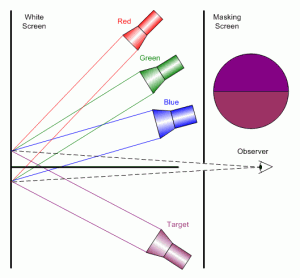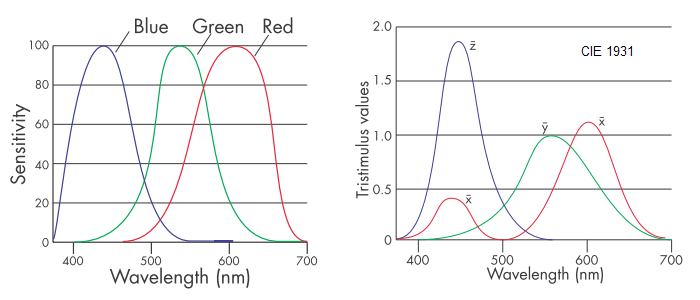 Color perception is a brain process that starts in the eye’s cone receptors. These receptors are found in three varieties that exhibit sensitivity to approximately red, green, and blue colors. The separation between colors is not clean and there is significant overlap between the sensitivities of all three varieties, particularly between the red and green cones.
Color perception is a brain process that starts in the eye’s cone receptors. These receptors are found in three varieties that exhibit sensitivity to approximately red, green, and blue colors. The separation between colors is not clean and there is significant overlap between the sensitivities of all three varieties, particularly between the red and green cones.
Most studies of the three-color nature of human vision are based on some variation of this simple apparatus (see the figure on the right).
One part of the screen is illuminated by a lamp of a target color; the other by a mixture of three colored lamps. Each of the lamps is called a stimulus and, in tightly controlled experiments, may consist of light of a single wavelength (monochromatic light source). The test subject (observer) adjusts the intensities of the three lamps until the mixture appears to match the target color.
Experiments have shown that certain combination of matching colors (usually some form of the primaries red, green, and blue) allow observers to match most, but not all, target colors. However, by adding light from one of these primaries to the target color, all possible target colors can be matched. The light added to the target color can be thought of as having been subtracted from the other two primaries – thus creating the theoretical notion of a negative amount of light [1,2]. This important observation shows that the trichromatic theory cannot generate all the colors perceived by the brain. On the other hand, the trichromatic theory allows a color vision modeling process that is practical and not overwhelmingly complex. In special cases, adding a fourth color is necessary in order to cover situations where using the trichromatic model does not lead to satisfactory results.
In 1931, the Commission Internationale de l’Éclairage (CIE) established standards for color representation based on the physiological perception of light. They are built on a set of three color-matching functions, collectively called the Standard Observer, related to the red, green and blue cones in the eye [1]. They were derived by showing subjects color patches and asking them to match the color by adjusting the output of three pure (monochromatic) colors of 435.8, 546.1, and 700 nm.
Definition: A tristimulus description of a color is one that defines the color in terms of three quantities, or stimuli.
Tristimulus descriptions of color have certain advantages over spectral data: tristimulus models human vision reasonably well, and can be plotted in three dimensions. The space defined by these three axes is called color space. Colors in one color space are converted to another color space by use of a transformation. A color space is an example of a more general concept called a color model.
References:
- Color Theory on Wikipedia
- Janet Lynn Ford – Color Theory Tutorial
- Danny Pascale – Color tutorials at BabelColor
- Birren, Faber – Light, Color, and Environment, Chicago, Van Nostrand Reinhold Company, 1969

